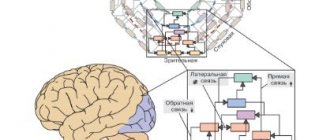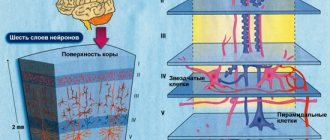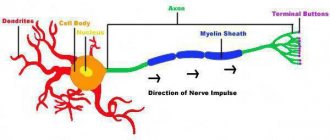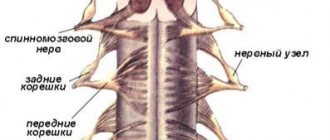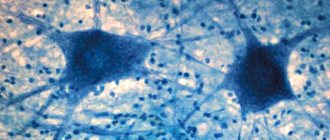Neuron structure
Each structure in the human body consists of specific tissues inherent to the organ or system. In nervous tissue - neuron (neurocyte, nerve, neuron, nerve fiber). What are brain neurons? This is a structural and functional unit of nervous tissue that is part of the brain. In addition to the anatomical definition of a neuron, there is also a functional one - it is a cell excited by electrical impulses, capable of processing, storing and transmitting information to other neurons using chemical and electrical signals.
The structure of a nerve cell is not as complex as that of specific cells of other tissues; it also determines its function. A neurocyte consists of a body (another name is soma), and processes - axon and dendrite. Each element of a neuron performs its own function. The soma is surrounded by a layer of fatty tissue, allowing only fat-soluble substances to pass through. Inside the body there is a nucleus and other organelles: ribosomes, endoplasmic reticulum and others.
In addition to the neurons themselves, the following cells predominate in the brain, namely: glial cells. They are often called brain glue for their function: glia serve as a support function for neurons, providing an environment for them. Glial tissue provides nerve tissue with the ability to regenerate, nourish, and assist in the creation of nerve impulses.
The number of neurons in the brain has always interested researchers in the field of neurophysiology. Thus, the number of nerve cells varied from 14 billion to 100. Recent studies by Brazilian specialists revealed that the number of neurons averages 86 billion cells.
Processes
The tools in the hands of a neuron are the processes, thanks to which the neuron is able to perform its function as a transmitter and storer of information. It is the processes that form a wide nerve network, which allows the human psyche to reveal itself in all its glory. There is a myth that a person’s mental abilities depend on the number of neurons or on the weight of the brain, but this is not so: those people whose fields and subfields of the brain are highly developed (several times more) become geniuses. Due to this, fields responsible for certain functions will be able to perform these functions more creatively and quickly.
Axon
An axon is a long extension of a neuron that transmits nerve impulses from the nerve soma to other similar cells or organs innervated by a specific part of the nerve column. Nature has endowed vertebrates with a bonus - myelin fiber, the structure of which contains Schwann cells, between which there are small empty areas - nodes of Ranvier. Along them, like a ladder, nerve impulses jump from one area to another. This structure makes it possible to speed up the transmission of information several times (up to about 100 meters per second). The speed of movement of an electrical impulse along a fiber that does not have myelin is on average 2-3 meters per second.
Dendrites
Another type of nerve cell extension is dendrites. Unlike the long and solid axon, the dendrite is a short and branched structure. This process is not involved in transmitting information, but only in receiving it. Thus, excitation reaches the neuron body using short dendritic branches. The complexity of information that a dendrite is capable of receiving is determined by its synapses (specific nerve receptors), namely its surface diameter. Dendrites, thanks to the huge number of their spines, are capable of establishing hundreds of thousands of contacts with other cells.
Metabolism in a neuron
A distinctive feature of nerve cells is their metabolism. Metabolism in the neurocyte is distinguished by its high speed and predominance of aerobic (oxygen-based) processes. This feature of the cell is explained by the fact that the work of the brain is extremely energy-intensive, and its need for oxygen is great. Although the brain weighs only 2% of the body's weight, its oxygen consumption is approximately 46 ml/min, which is 25% of the body's total consumption.
The main source of energy for brain tissue, in addition to oxygen, is glucose , where it undergoes complex biochemical transformations.
Ultimately, large amounts of energy are released from the sugar compounds. Thus, the question of how to improve neural connections in the brain can be answered: eat foods containing glucose compounds.
Functions of a neuron
Despite its relatively simple structure, the neuron has many functions, the main ones of which are the following:
- perception of irritation;
- stimulus processing;
- impulse transmission;
- formation of a response.
Functionally, neurons are divided into three groups:
Afferent (sensitive or sensory). Neurons in this group perceive, process and send electrical impulses to the central nervous system. Such cells are anatomically located outside the central nervous system, but in spinal neuronal clusters (ganglia), or the same clusters of cranial nerves.
Intermediaries (also these neurons, which do not extend beyond the spinal cord and brain, are called interneurons). The purpose of these cells is to ensure contact between neurocytes. They are located in all layers of the nervous system.
Efferent (motor, motor). This category of nerve cells is responsible for transmitting chemical impulses to the innervated executive organs, ensuring their performance and setting their functional state.
In addition, another group is functionally distinguished in the nervous system - inhibitory nerves (responsible for inhibiting cell excitation). Such cells resist the propagation of electrical potential.
Classification of neurons
Nerve cells are diverse as such, so neurons can be classified based on their different parameters and attributes, namely:
- Body shape. In different parts of the brain there are neurocytes of different soma shapes: stellate;
- fusiform;
- pyramidal (Betz cells).
- unipolar: have one process;
- axo-somatic. In this case, the axon contacts the soma of the neighboring cell of the nervous tissue;
Types of neurons
In order to carry out conscious movements, it is necessary that the impulse formed in the motor convolutions of the brain can reach the necessary muscles. Thus, the following types of neurons are distinguished: central motor neuron and peripheral motor neuron.
The first type of nerve cells originates from the anterior central gyrus, located in front of the largest groove of the brain - Roland's groove, namely from Betz's pyramidal cells. Next, the axons of the central neuron deepen into the hemispheres and pass through the internal capsule of the brain.
Peripheral motor neurocytes are formed by motor neurons of the anterior horns of the spinal cord. Their axons reach various formations, such as plexuses, spinal nerve clusters, and, most importantly, the performing muscles.
Conclusion
Human physiology is striking in its coherence. The brain has become the greatest creation of evolution. If we imagine the body in the form of a coherent system, then neurons are wires through which signals pass from the brain and back. Their number is huge, they create a unique network in our body. Thousands of signals pass through it every second. This is an amazing system that allows not only the body to function, but also contact with the outside world.
Without neurons, the body simply cannot exist, so you should constantly take care of the state of your nervous system. It is important to eat right, avoid overwork, stress, and treat diseases in a timely manner.
Pathways
The nervous system has its spheres of influence throughout the body. With the help of conductive fibers, nervous regulation of systems, organs and tissues is carried out. The brain, thanks to a wide system of pathways, completely controls the anatomical and functional state of every structure of the body. Kidneys, liver, stomach, muscles and others - all this is inspected by the brain, carefully and painstakingly coordinating and regulating every millimeter of tissue. And in case of failure, it corrects and selects an appropriate model of behavior. Thus, thanks to the pathways, the human body is characterized by autonomy, self-regulation and adaptability to the external environment.
Brain pathways
A pathway is a collection of nerve cells whose function is to exchange information between different parts of the body.
- Association nerve fibers. These cells connect various nerve centers located in the same hemisphere.
- Commissural fibers. This group is responsible for the exchange of information between similar centers of the brain.
- Projection nerve fibers. This category of fibers articulates the brain with the spinal cord.
- Exteroceptive pathways. They carry electrical impulses from the skin and other sensory organs to the spinal cord.
- Proprioceptive. This group of pathways carries signals from tendons, muscles, ligaments and joints.
- Interoceptive pathways. The fibers of this tract originate from internal organs, blood vessels and intestinal mesenteries.
"Snail" of a newborn rat
0
This stunning image, which took eighth place in the 2021 Nikon Small World competition, shows us the main organ through which we hear: the snail. Hair cells are shown in green, the deviation of which triggers a nerve impulse that ultimately arrives in the auditory cortex. Red - nerve cells of the cochlea, “collecting” signals from hair cells.
Interaction with neurotransmitters
Neurons of different locations communicate with each other using electrical impulses of a chemical nature. So, what is the basis of their education? There are so-called neurotransmitters (neurotransmitters) - complex chemical compounds. On the surface of the axon there is a nerve synapse - the contact surface. On one side there is a presynaptic cleft, and on the other there is a postsynaptic cleft. Between them there is a gap - this is the synapse. On the presynaptic part of the receptor there are sacs (vesicles) containing a certain amount of neurotransmitters (quanta).
When the impulse approaches the first part of the synapse, a complex biochemical cascade mechanism is initiated, as a result of which the sacs with mediators are opened, and quanta of mediator substances smoothly flow into the gap. At this stage, the impulse disappears and reappears only when the neurotransmitters reach the postsynaptic cleft. Then biochemical processes are activated again with the opening of the gates for mediators and those, acting on the smallest receptors, are converted into an electrical impulse that goes further into the depths of the nerve fibers.
Meanwhile, different groups of these same neurotransmitters are distinguished, namely:
- Inhibitory neurotransmitters are a group of substances that exert an inhibitory effect on excitation. These include: gamma-aminobutyric acid (GABA);
- glycine.
- acetylcholine;
Do nerve cells recover?
For a long time it was believed that neurons are not capable of division. However, this statement, according to modern research, turned out to be false: in some parts of the brain, the process of neurogenesis of neurocyte precursors occurs. In addition, brain tissue has remarkable abilities for neuroplasticity. There are many cases where a healthy part of the brain takes over the function of a damaged one.
Many experts in the field of neurophysiology have wondered how to restore brain neurons. Recent research by American scientists has revealed that for timely and proper regeneration of neurocytes, there is no need to use expensive drugs. To do this, you just need to create the right sleep schedule and eat right, including B vitamins and low-calorie foods in your diet.
If a disruption occurs in the neural connections of the brain, they are able to recover. However, there are serious pathologies of nerve connections and pathways, such as motor neuron disease. Then it is necessary to turn to specialized clinical care, where neurologists can find out the cause of the pathology and formulate the correct treatment.
People who have previously consumed or are drinking alcohol often ask the question of how to restore brain neurons after alcohol. A specialist would answer that for this you need to systematically work on your health. The range of activities includes a balanced diet, regular exercise, mental activity, walks and travel. It has been proven that the neural connections of the brain develop through the study and contemplation of information that is completely new to humans.
In conditions of oversaturation with unnecessary information, the existence of the fast food market and a sedentary lifestyle, the brain is qualitatively susceptible to various damages. Atherosclerosis, thrombotic formation on blood vessels, chronic stress, infections - all this is a direct road to brain clogging. Despite this, there are medications that restore brain cells. The main and popular group is nootropics. Drugs in this category stimulate metabolism in neurocytes, increase resistance to oxygen deficiency and have a positive effect on various mental processes (memory, attention, thinking). In addition to nootropics, the pharmaceutical market offers drugs containing nicotinic acid, agents that strengthen the walls of blood vessels, and others. It should be remembered that restoring neural connections in the brain when taking various drugs is a long process.
Immune cells heal brain after bleeding
0
In a new paper in Nature Communications, Houston neuroscientists show how immune cells called neutrophils can repair the brain after a hemorrhagic stroke. Neutrophils are known as the "infantry" in the body's war against infection. It turns out that they have another function: a new study shows that these immune cells may play a crucial role in protecting the brain from stroke, and can also be used in the treatment of intracerebral hemorrhages.
